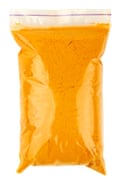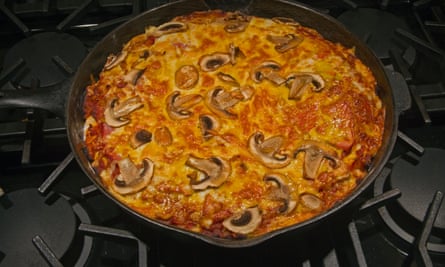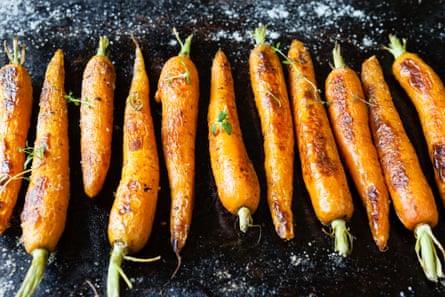If you have ever tried to re-create a restaurant dish at home, you will almost certainly have been perplexed by the experience. No matter how much care and attention you give to your version, something seems to be missing when you tuck in. What are chefs doing differently? Here, 27 professionals divulge their favourite kitchen trick – the one unexpected riff that keeps them ahead of the pack.
“A little tip for roast potatoes is to put a bit of Marmite in the water when you’re parboiling the potatoes. It gives them a really nice colour and will present you with deep-golden roasties every time.” Simon Shaw, chef patron and creative director at El Gato Negro, Canto and Habas, Manchester
“To thicken curries, soups and stews, add in chopped, boiled sweet potato. It dissolves into the dish, adds sweetness and creates a thick and tasty sauce.” Lisa Marley, chef trainer for ProVeg UK
“For juicy, tender meat, blend fresh celery and add it to your marinades. This helps to tenderise the meat before cooking, giving you the perfect flavour.” Kerth Gumbs, head chef at Fenchurch restaurant, London

“When preparing sturdier green vegetables, such as green beans or asparagus, they are ordinarily very dry. I soak them in cold water for at least one hour before cooking in boiling, heavily salted water. Once al dente, I drop them into iced water. The whole process really brings out the colour and ensures a lush, green, crisp vegetable – ideal for adding to salads.” Matt Fletcher, chef de cuisine at Great Central Pub by Matt Fletcher at the Landmark London Hotel
“Here’s how to refresh dying or drying herbs: put ice-cold water and potato trimmings in a cup or glass, then add bunches of coriander, parsley or tarragon that are past their best. They come back to life within 30 minutes of standing in the starchy water.” Michael Carr, executive chef at the Old Vol and the Reindeer, Nottingham
“Rinse scallops in sparkling water instead of still, as the bubbles will remove any hidden grit.” Adebola Adeshina, chef patron at Chubby Castor, Cambridgeshire
“People are always asking me for rice to water ratios. I seldom measure anything so I can’t tell you in cups, but here is a simple trick for measuring the right amount. Stick your index finger perpendicular to the surface of the rice in the pan and add water until it reaches the first joint of your finger. No idea why it works given different sizes of hands and pans, but it does.” Amy Poon, founder of Poon’s, London

“I recommend keeping small quantities of dry powdered spices in jars for immediate use, with the rest stored in ziplock bags, which keep them fresher for longer. That’s how I store my pomegranate powder that I bring back from Punjab.” Nidhi Verma, chef at the Cookaway
“Roasted garlic oil is a fantastic base for all cooking. I roast peeled garlic with oil at about 140C until golden brown, which takes about an hour. Once it has cooled, you can separate the oil from the garlic, make a paste from the garlic and put the oil in a bottle. These will keep in the fridge and add flavour to pretty much anything you are cooking.” Daniel Heffy, chef at Nord, Liverpool
“If you’re cooking burgers on the barbecue or on a grill in your kitchen, push down on the centre of your patty to form a sort of doughnut. This little trick will allow more airflow around the burger, allowing it to cook evenly without the centre swelling up.” Sam Idione, head chef, Roots + Seeds Kitchen Garden, Cirencester Park
“To make your homemade pizza equal to that of Italian pizzerias, try double cooking: first a few minutes in a large frying pan and then in the oven at a very high temperature. This allows the pizza to brown evenly on the surface.” Vittorio Meli, head chef at Zoom East, London

“At the restaurant, we make an emulsion that is perfect for glazing or seasoning blanched vegetables. In a pan, whisk together 20ml of cream with a chicken (or veg) stock cube and bring to a simmer. Add in your vegetables of choice, season with salt, pepper and sugar, and reduce until the veg is glazed. It works perfectly with spinach, cavolo nero and carrots, giving them more of a rich and meaty flavour.” Kevin Dalgleish, chef patron at Amuse, Aberdeen
“When I make chana masala, I create the distinctive colour and flavour by adding a teabag to the curry. Chickpeas tend to dry out when you cook them and a teabag also helps to retain moisture. Just be careful to take it out before serving!” Dipna Anand, chef patron at Dipna at Somerset House, London
“I hate to waste food and I love this little trick to elevate your Chinese or any south-east Asian cuisine: using vegetable skins or ends to flavour your oils. Garlic skin, spring onion ends (washed and dried on a tea towel), clean onion skins and ginger peel work a treat if cooked low and slow (for 30 minutes or so) in a pool of vegetable oil. Then use it to cook stir-fries or anything else. It adds a real depth of flavour, but your guests will have no idea where the deliciousness came from.” Jeremy Pang, chef and founder of School of Wok
“If cooking for two, the easiest thing to do is to buy a steak big enough for both of you, rather than two separate steaks. Sear it in the pan, then put it into a pre-heated oven at 200C (gas mark 6) and immediately turn the oven off. This will cook and rest the bigger cut at the same time, giving you time to pop out for a drink. My timings for each steak are as follows if you live a couple of minutes’ walk from the pub: a generous fillet is time for one pint, a generous sirloin is time for two pints, and a generous côte de boeuf is time for three pints. You will return to a beautifully cooked steak.” Tom De Keyser, head chef at the Hand & Flowers, Marlow
“Toast the rice when making risotto. The key is to add the rice to the pan first, without any oil or butter as this could burn it. You can tell when it’s done when the rice is dry and hot to touch. Doing this ensures the grain is sealed, and doesn’t become mushy as you add the stock.” Manuel Prota, head chef at Jacuzzi, London
after newsletter promotion
“Don’t cook vegetables in plain water. Instead, treat it as a cooking step to increase flavour. Cook any greens in a seaweed broth (use shimaya konbu stock). Always cook carrots in carrot or orange juice where possible, because it really heightens the flavour and brings out the sweetness.” Sam Grainger, owner and chef at Belzan and Madre, Liverpool

“Try cooking vegetables whole. Roast a whole carrot, barbecue a whole leek, bake a whole beetroot, blanch a whole courgette, simmer whole cabbages. I always do this in the restaurant and at home because you get the maximum flavour out of your ingredient instead of washing the taste and nutrients out into the boiling water and then down the sink. Once cooked, you can then trim and portion.” Kirk Westaway, executive chef at Jaan, Singapore
“There’s an old trick called velveting that works for tenderising cheaper cuts of meat. Mix a teaspoon of baking powder in 250ml water. Pour over your meat (up to about 280g for these measurements) and leave it to marinade for no longer than 15 minutes. Then wash it off and pat dry. This process raises the pH level on the meat’s surface, which will keep it tender and soft when you cook it.” Mike Reid, executive chef at M Restaurants, London and Gaucho, nationwide
“A lot of cake recipes tell you to swap some of the flour for cocoa powder if you want to make a chocolate version, but that makes for a dry cake. I always recommend using cooled hot chocolate as well to keep it moist. Pour two or three tablespoons over each layer and wait until it has soaked in before frosting.” Adeline Vining, baker at Heirloom Cafe, Edlesborough
“I always add a pinch of salt when I create a sorbet. It really helps bring out the flavour of the fruit and enhances acidity.” Jude Sam, head chef at Apothecary East, London
“If you’re making pizza, stretch out your sourdough as normal, then put two or three ice cubes on it before you place it in a pizza oven. The ice melts down to a starchy sauce. Pull it out, add cheese, pop back in and you get this lovely gooey cheesy sauce on the top. It’s quite a traditional technique – the end result is a little like cacio e pepe (cheese and pepper pasta) – but not a lot of people have heard of it and it’s very rarely done.” Paul Foster, chef patron at Salt, Stratford-upon-Avon
“I always cook greens towards the end of a roast dinner. I love to sauté them in a pan with leftover chicken-fat reduction. It’s a great byproduct and makes them super-tasty. Simply collect what comes off the tray from your roast chicken and pass through a strainer. Reduce it down to a stock and it’s ready for your greens.” Aktar Islam, chef patron at Opheem, Birmingham

“You can do a lot with soy sauce. Brush a whole chicken with it before roasting, to add flavour and help crisp up the skin with gorgeous colour. I also like to add it to gravy, for extra umami flavour.” Judy Joo, founder of Seoul Bird, London
“An older chef, some time ago, urged me to add a dollop of mayonnaise to a hollandaise sauce. This helps the hollandaise keep its consistency for many hours and stops it from splitting. It also allows the sauce to hold its creamy nature during reheating.” Ahmed Abdalla, head chef at Legacy, York
“Spoon out excess fat from stocks, stews, and sauces by skimming a few ice cubes (wrapped in a paper towel or cheese cloth) along the surface of the liquid. The ice helps the fat solidify, making it easier to remove with a spoon (or even a piece of toast).” Sohan Bhandari, head chef at Colonel Saab, London
“Adding white wine vinegar to water while boiling potatoes keeps them firm on the outside and soft on the inside. The acid in the vinegar prevents the pectin from breaking down too quickly in the outer part of the potato and it will remain compact and firm. This is great for making potato salad – or anything where you want to mix the potato with other ingredients.” Giovann Attard, executive head chef at Norma, London






